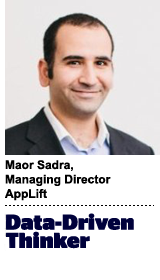 “Data-Driven Thinking” is written by members of the media community and contains fresh ideas on the digital revolution in media.
“Data-Driven Thinking” is written by members of the media community and contains fresh ideas on the digital revolution in media.
Today’s column is written by Maor Sadra, managing director at AppLift.
There’s been a lot of prattle about the potential of header bidding. Some have even called it waterfalling by a different name, and that with some tweaking to header bidding’s implementation it could be a positive development for the industry.
But I don’t believe that header bidding will ever be a positive development. It is not a waterfall – it is Niagara Falls. Header bidding’s adoption will thwart the advancement of programmatic advertising.
The aim of programmatic is to create a more efficient marketplace, one in which prices are set by supply and demand. Header bidding allows publishers to offer inventory on multiple exchanges rather than filtering demand through a single stream. Most DSPs are connected to most of the leading exchanges. If a DSP registers the same inventory from four different exchanges, it is going to bid the same price across all four, potentially increasing its price.
In other words, the DSP is bidding against itself and inflating the ad space’s value. That may make publishers more money, but it also wastes server resources. Furthermore, when advertisers realize prices are going up, they’ll be motivated to cut out the programmatic loop entirely and strike direct deals with publishers. This will essentially set us back to the early 2000s, with advertisers signing and faxing insertion orders to buy impressions in bulk.
One of the benefits of programmatic is that it makes it possible to evaluate each individual impression and lets the market determine its worth, much like the stock exchange. But header bidding tips the scale, allowing publishers to generate unfair prices at the expense of the demand side.
The inflated prices are obviously bad for advertisers, but they are also bad for the entire digital ecosystem. When advertisers opt out of programmatic, they forfeit its improved targeting and efficiency-enhancing capabilities. Publishers may gain a bit in the short term by squeezing more yield from their existing inventory, but in the long run they are hurting themselves.
One of the biggest challenges mobile advertising faces is that there is more supply than demand. Programmatic makes it easier for companies to buy digital advertising, thus expanding the demand side of the ecosystem. It commoditizes media trading via an open exchange and objectively evaluates each impression to determine its true market value.
When publishers force higher prices for their current demand, they are potentially slowing down the progression of programmatic for all of the demand that isn’t there yet – the future buyers who could help even the playing field and address mobile’s impression surplus.
Because the inflated prices that header bidding generates will encourage advertisers to cut out the exchange and strike direct deals with publishers, programmatic’s growth will slow and mobile’s supply-and-demand problem will continue unchecked.
Let’s take a common example that happens daily. A publisher monetizes its app in the open marketplace through a single supply-side platform (SSP). Ad impressions are auctioned by three different demand-side platforms (DSPs). The highest bidder wins and pays on a second-price auction.
But if the publisher includes a header-bidding tag on its unsold inventory, the next time an impression becomes available, it is sent to two SSPs. The first SSP runs an auction across DSPs A, B and C, while the second SSP simultaneously runs an auction across DSPs B, C and D.
In this scenario, which is indicative of a typical header-bidding transaction, DSPs B and C bid on the same potential impression twice, once on the first SSP and again on the second SSP. In doing so, they’re wasting server resources, but worse, they are bidding against themselves.
Let’s pretend DSP A would have been the highest bidder if the impression was only auctioned on the first SSP. Instead, it loses to DSP D and will never know the actual price the auction cleared at since the SSP only has data pertaining to its own platform, not transactions occurring on the second SSP.
If DSP A still wants inventory from the publisher, its best bet is to reach out directly to propose a direct deal in which they bypass the exchange entirely. If the publisher agrees, the entire RTB marketplace misses out on that traffic.
This temporarily solves a problem since the DSP gets its desired impressions, although at a potentially higher rate than necessary. The publisher also successfully sells its impressions but in the long term, it only exasperates the industry’s supply-and-demand issue by removing quality supply from the marketplace.
The downside of header bidding for existing advertisers is blatant. They stand to pay more for the same traffic. The risks for publishers are more subtle, but just as alarming. Header bidding could thwart the growth of programmatic. If advertisers abandon the exchange and start striking direct deals, we forfeit programmatic’s advanced targeting abilities and deep data, as well as its efficiencies.
Programmatic makes it easier to access the digital advertising marketplace. It makes it easier to purchase advertising. Why build barriers? Why risk shrinking the demand-side pool?
Publishers need to remember the long game. We all win by fostering an efficient, transparent advertising ecosystem.
Follow AppLift (@applift) and AdExchanger (@adexchanger) on Twitter.












